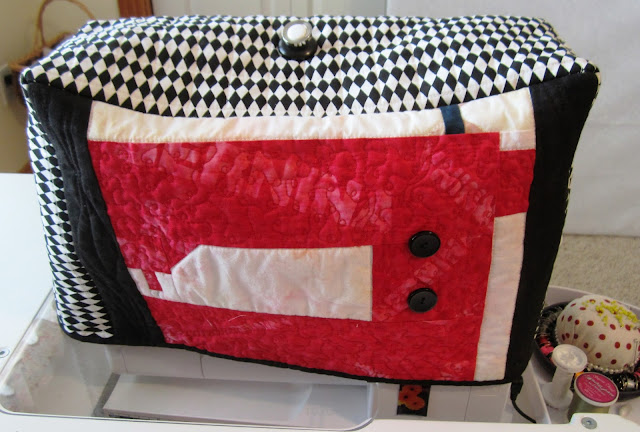In my last post, I mentioned a surprize for a friend of mine. I started working on it right away and want to share the process with you. First off, use a picture with good composition with few details as it will be easier to convert. I use photo editing software to convert color photos to black and white and posterize the image which will give you 3-4 shaded areas where contrast is high on the subjects features. When I made this green challenge quilt, I used close up pictures of my DH, DS and myself. The challenge was to create a quilt measuring 6" X 24" with greens and muslin/calico. The picture to the left looks pink, but I assure you it's muslin and not good lighting for this photo. This was an odd size and for most of the participants, the challenge turned into table runners. For me, I wanted something that would hang in a tight space and try out the portrait technique.
Getting back to my friend, she is a proud Grandmother and doesn't get the chance to see her son's family as much as she would like as they live out of state. She sent this picture and I just couldn't resist in trying the portrait technique again.
So, like I said the first thing to do is to turn it into a black and white photo.
Then, using photo editing software you posterize it. If you have patience and a great photo software program, play with the image to get it the way you want it. You could turn it into a real work of art. You will be able to edit, save, change or even delete several files until you get the one you like. Choose what colors you want to use at this point.
Sketch drawing
Color Posterized photo
 |
| Slightly Posterized Posterized to show zones of contrast
|
The next step is to print to your paper. I wanted to keep it small, but you could make a huge quilt from the printed image. I also drew out the image onto freezer paper so that the image wouldn't be reversed when fused and appliqued onto the background.
You can see my sketch on the freezer paper above. Fuse the steam a seam or other light weight bondable product to the back side of your fabrics. Cut the freezer shapes out and fuse onto the right side of your fabric and use a teflon sheet underneath where the fusible is. You don't want to fuse it onto your ironing board. Then you carefully cut each piece and layer it onto the background. Choose what should go down first. In my case, white was the most prominent fabric used. Then gray and finally just a few black contrast pieces. Carefully iron the shapes in place. Check to make sure they are placed correctly, again you don't want to fuse the shapes onto the ironing board or the bottom of your iron. Why do I keep stressing this....experience! I've been there and done that before.
When you have it fused and ready to go, pin it on your design board and step back. How does it look, make any changes now before you start your stitching. I made a few changes at this stage. The babies head didn't look right to me and the hat looked cut off on the very top.
Now you can choose your stitching technique and threads. I used monopoly thread in the top and bottom and zig zagged around each shape. Take your time, it's not a race, put some music on and enjoy the process.
Yes, I'm old so I have to use my magnifyer when I sew small spaces. When you've completed this step put it back on your design board and take a picture. Now, layer your batting and backing and pin or baste together. Quilt inside your shapes first saving the background for last. I find this to be easier as you assign zones and keep your mind straight on what is to be done and where. So, here I started quilting the white areas on the faces. Leaving all the contrast alone. I used white to blend. On the background, I used gray thread lines to bring out the brick pattern.
Now you're ready to trim, add the binding and finish the quilt. I went back and fixed a spot on the hat and removed the gray contrast piece on the babies head. Don't forget to add a label to the back. The finished size is 9" X 11" with a label on the reverse stating who is in the picture, who made the quilt, date and who it is for.
Now I want to do another one. I have the coolest picture of my Dad when he was 17 years old. I am thinking of sticking to the black, white and gray look. But, I may change my mind as I very rarely do something the same way twice.





















.JPG)
.JPG)


.JPG)
.JPG)
.JPG)


.jpg)